Fire safety is a critical aspect of ensuring the safety and well-being of individuals in any environment, from homes and workplaces to public spaces. Among the many tools used to enhance preparedness and response during emergencies, fire safety signs are vital in providing clear, visual instructions that can save lives. These signs, designed with universally recognized symbols, colors, and shapes, guide people to safety, mark emergency equipment locations, and outline crucial actions to take during a fire.
In this blog, we’ll explore over 30 essential fire safety signs, their meanings, and how they contribute to creating safer spaces and effective emergency response systems.
30+ Fire Safety Signs and Their Meanings
Fire safety signs are essential for guiding individuals during emergencies and ensuring compliance with safety regulations. They use specific colors, shapes, and symbols to convey important information quickly and effectively. Here’s an overview of common fire safety signs and their meanings:
1. Fire Extinguisher Sign
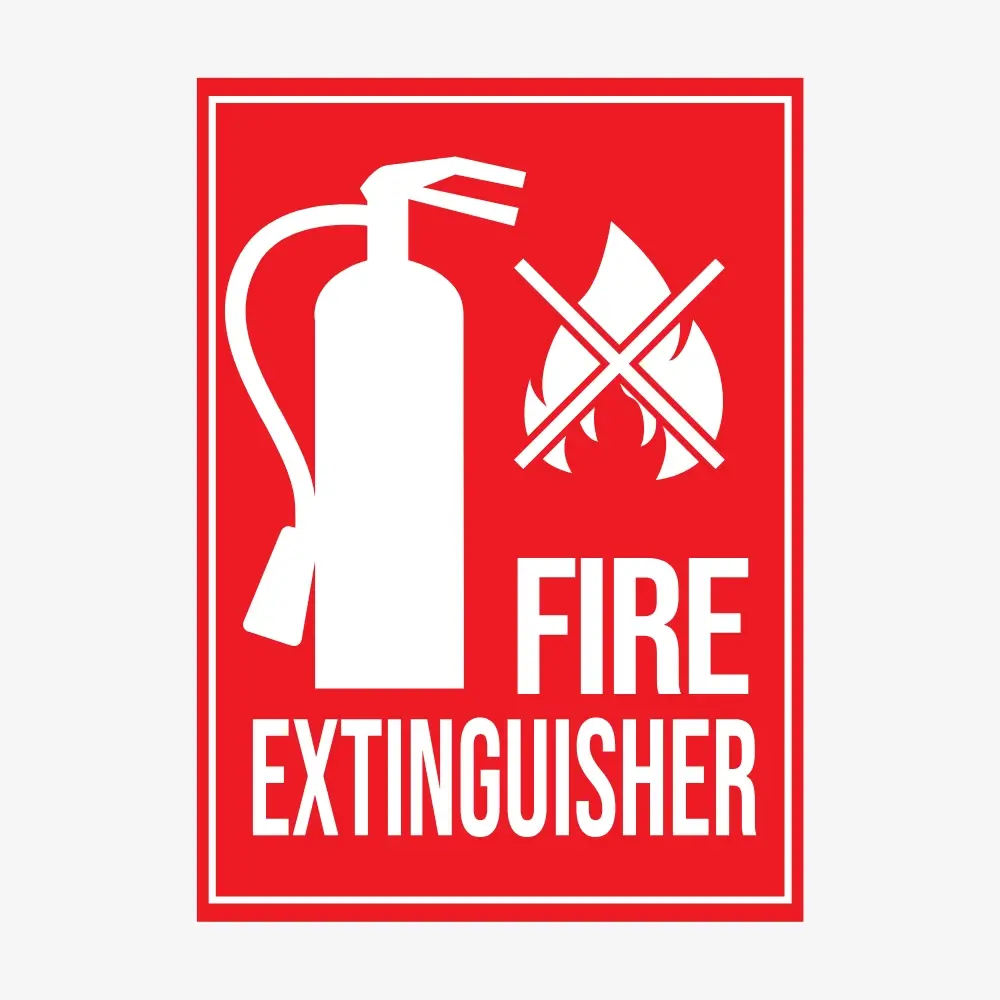
Fire extinguisher signs are safety indicators that help locate fire extinguishers during emergencies.
Key Features:
- Appearance: Red background with a white fire extinguisher symbol or text.
- Purpose: Mark the location of fire extinguishers for quick access.
- Placement: Above or near the extinguisher, at eye level or along escape routes.
- Standards: Follow international safety regulations (e.g., ISO 7010).
These signs ensure visibility and aid in swift action during fire incidents.
2. Fire Alarm Call Point Sign
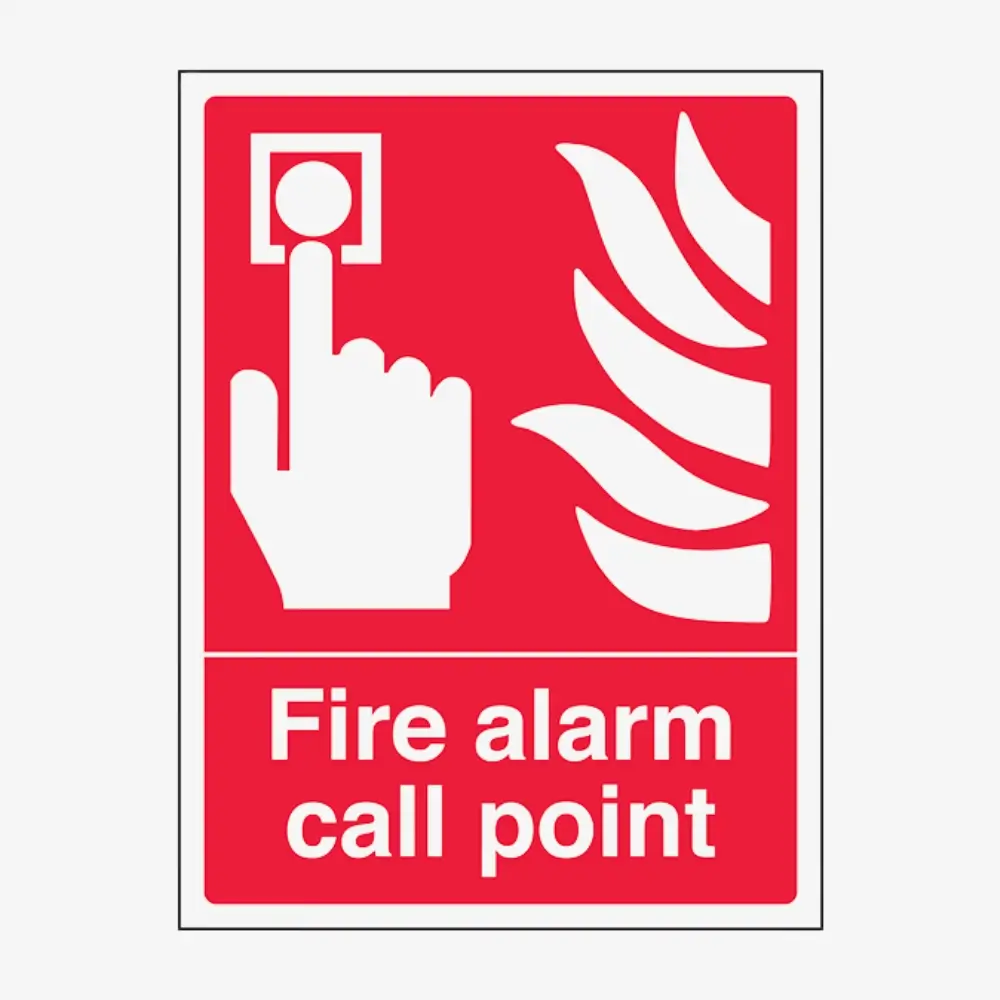
Fire Alarm Call Point Signs are safety signs that indicate the location of manual fire alarm activation points. These signs help individuals quickly find and activate the emergency fire alarm system.
Key Features:
- Appearance: Red background with a white symbol (a hand pressing a button or breaking glass) or text like “Fire Alarm Call Point.”
- Purpose: Guides people to the nearest manual alarm point to raise an alert in case of a fire.
- Placement: Positioned near fire alarm call points, typically along escape routes or near exits.
They ensure quick identification and access to fire alarm systems, enhancing safety and emergency response efficiency.
3. Fire Hose Reel Sign
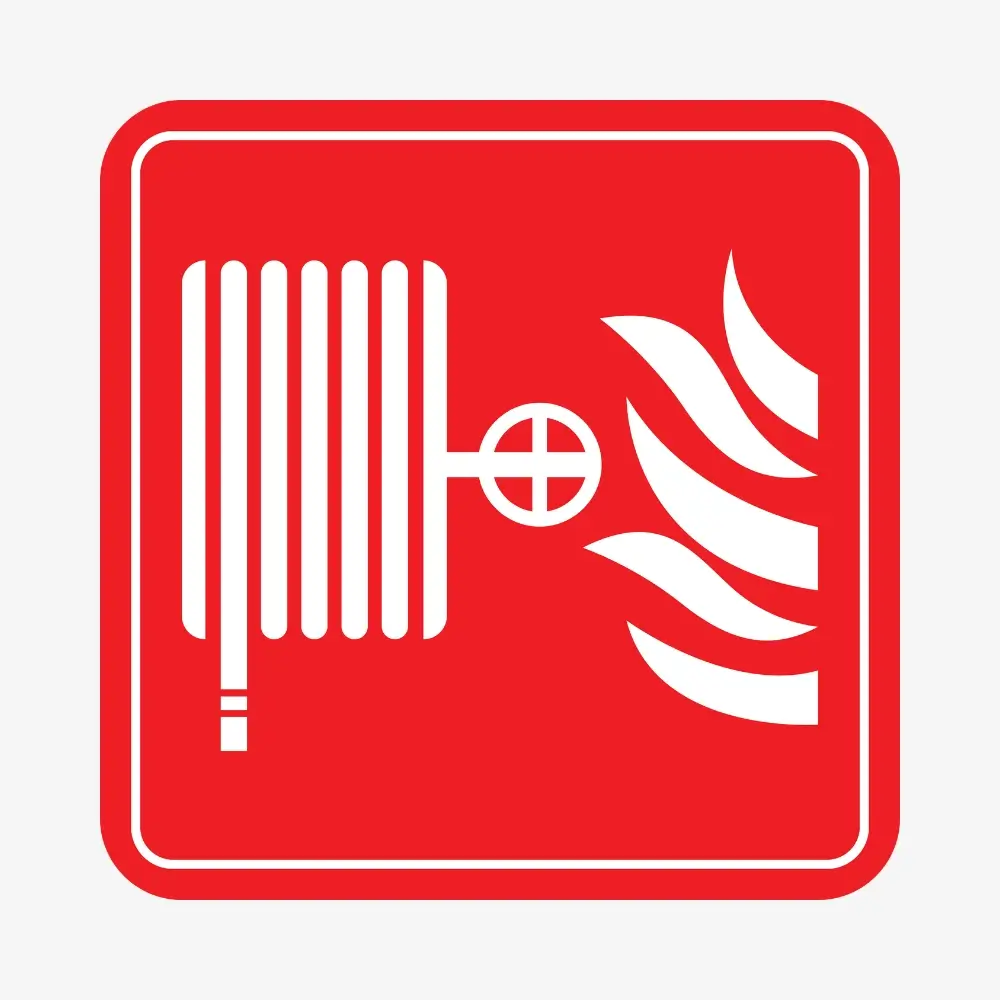
Fire Hose Reel Signs are safety signs used to indicate the location of fire hose reels, which are essential firefighting equipment.
Key Features:
- Appearance: Red background with a white symbol of a hose reel and text such as “Fire Hose Reel.”
- Purpose: Marks the location of fire hose reels, ensuring they are easily identifiable during emergencies.
- Placement: Positioned above or near fire hose reels, typically along corridors or in areas where fire equipment is stored.
These signs guide individuals to fire hose reels quickly, aiding in fire control and ensuring compliance with safety regulations.
4. Fire Exit Sign
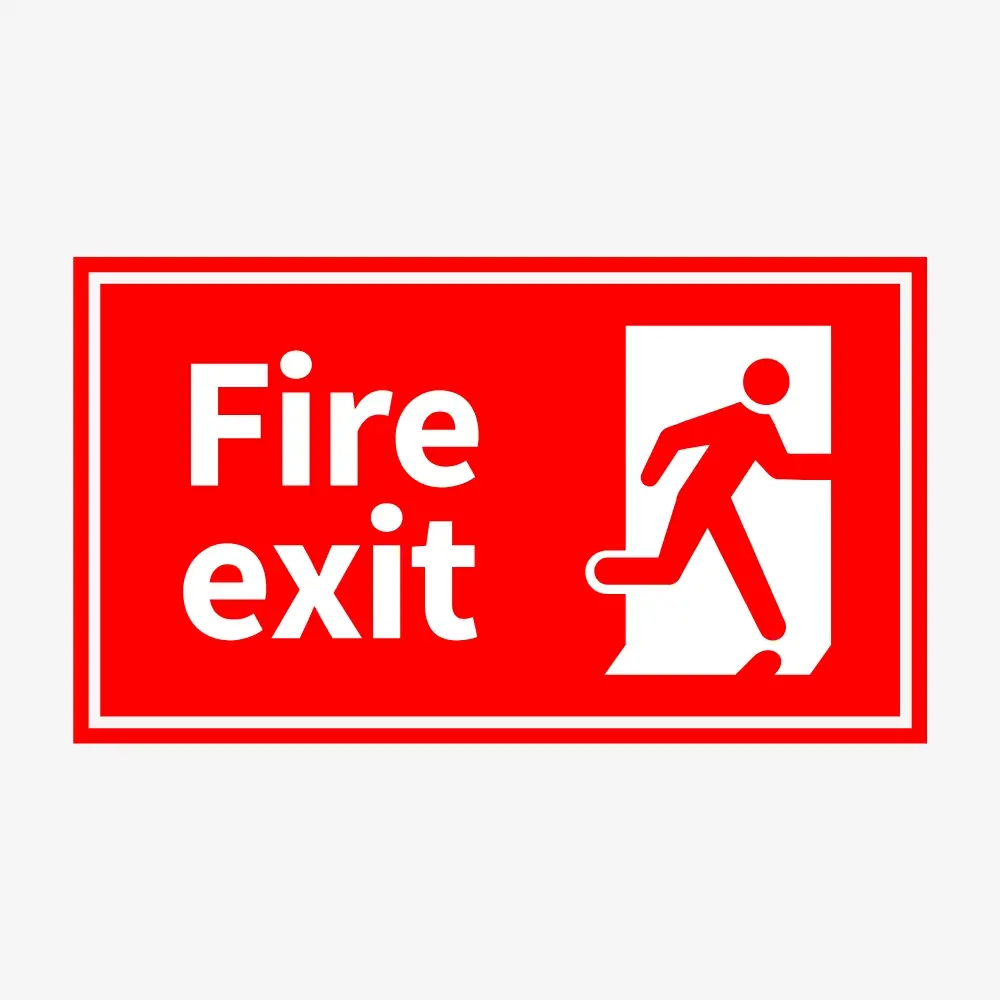
Fire Exit Signs are safety signs that indicate the location of emergency exits and escape routes to guide people to safety during emergencies.
Key Features:
- Appearance: Green background with a white pictogram (a running figure and an arrow) and optional text like “Fire Exit.”
- Purpose: Directs individuals to the nearest safe exit during an evacuation.
- Placement: Positioned above or beside doors, along escape routes, and at junctions where direction is needed.
These signs enhance visibility and ensure a clear path to safety, reducing confusion during emergencies and facilitating a swift evacuation.
5. Fire Door Keep Shut Sign

Fire Door Keep-Shut Signs are mandatory safety signs placed on fire doors to instruct people to keep the door closed at all times unless it is in use.
Key Features:
- Appearance: Blue circular sign with white text reading “Fire Door Keep Shut.”
- Purpose: Ensures fire doors remain closed to prevent the spread of fire and smoke, protecting escape routes and limiting fire damage.
- Placement: Positioned on both sides of fire doors, at eye level, for maximum visibility.
These signs are crucial for maintaining fire safety. Closed fire doors help contain fire and smoke, providing occupants with more time to evacuate safely.
6. No Smoking Sign

No Smoking Signs are safety signs that prohibit smoking in specific areas to reduce fire risks and maintain compliance with regulations.
Key Features:
- Appearance: A red circle with a diagonal line over a cigarette symbol.
- Purpose: Communicates that smoking is not allowed in the designated area, helping to prevent fire hazards and promote health and safety.
- Placement: Commonly found in areas with flammable materials, public buildings, workplaces, and transportation hubs.
These signs help prevent potential fire incidents and ensure adherence to legal requirements, creating a safer environment for everyone.
7. Fire Assembly Point Sign

Fire Assembly Point Signs are safety signs that indicate the designated safe location where people should gather during an emergency evacuation.
Key Features:
- Appearance: Green background with a white pictogram showing a group of people or arrows pointing to a central figure, often accompanied by the text “Fire Assembly Point.”
- Purpose: Directs evacuees to a pre-determined area where attendance can be taken and further instructions given.
- Placement: Located in visible, accessible outdoor areas away from the building and potential fire hazards.
These signs ensure orderly evacuation, help account for all individuals, and assist emergency responders in managing the situation effectively.
8. Fire Action Notices Sign

Fire Action Notice Signs provide instructions on what to do in the event of a fire, ensuring clear guidance during emergencies.
Key Features:
- Appearance: Blue and white signage with step-by-step text instructions, often customized for specific premises.
- Purpose: Outlines fire safety procedures such as raising the alarm, evacuating, and calling emergency services.
- Placement: Positioned in prominent locations like corridors, stairwells, near fire alarm call points, and exits.
These signs help occupants act quickly and correctly in a fire, reducing panic and ensuring a coordinated response to enhance safety.
9. Fire Blanket Sign
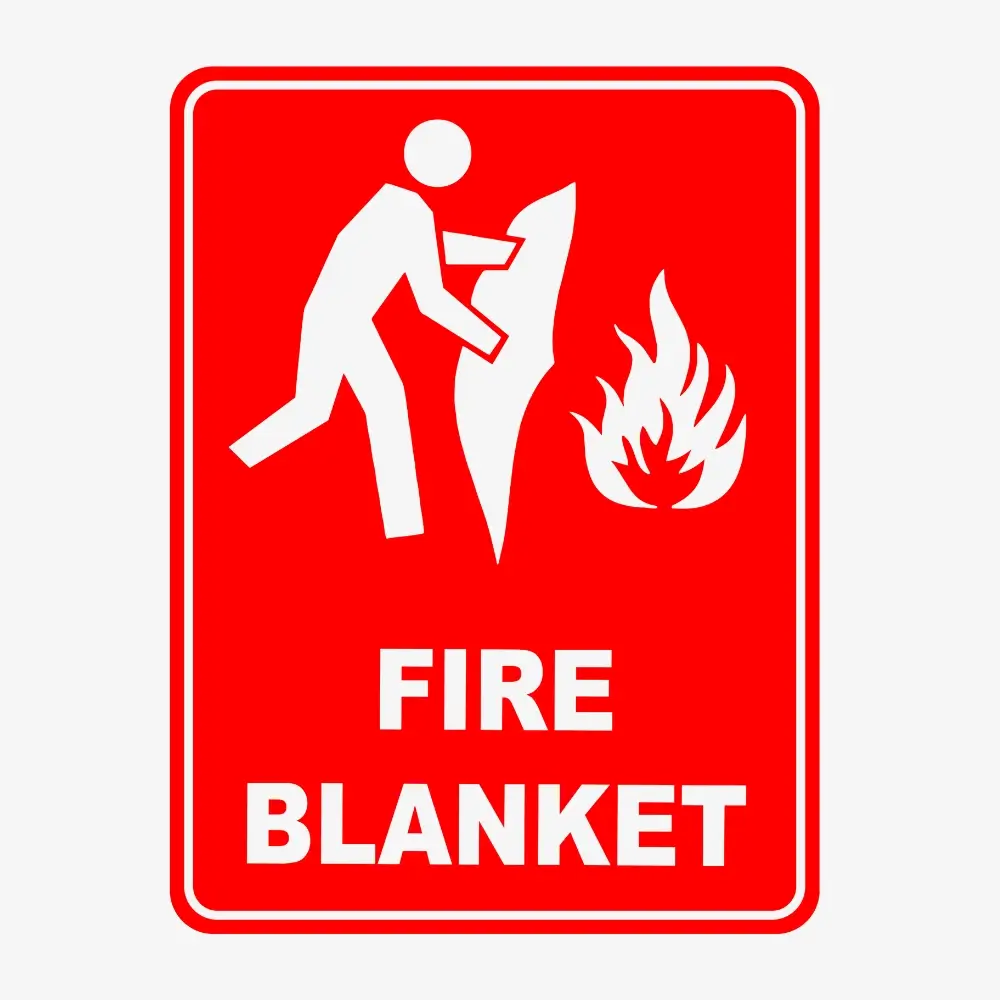
Fire Blanket Signs are safety signs that indicate the location of fire blankets, which are used to extinguish small fires or wrap around a person to protect them from flames.
Key Features:
- Appearance: Red background with a white fire blanket symbol or text, often accompanied by instructions for use.
- Purpose: Mark the location of fire blankets to ensure they are easily accessible during emergencies.
- Placement: Positioned near fire blankets, typically in kitchens, laboratories, or areas with a higher risk of small fires.
These signs ensure quick identification and access to fire blankets, aiding in effectively handling minor fires and enhancing overall safety.
10. Emergency Telephone Sign
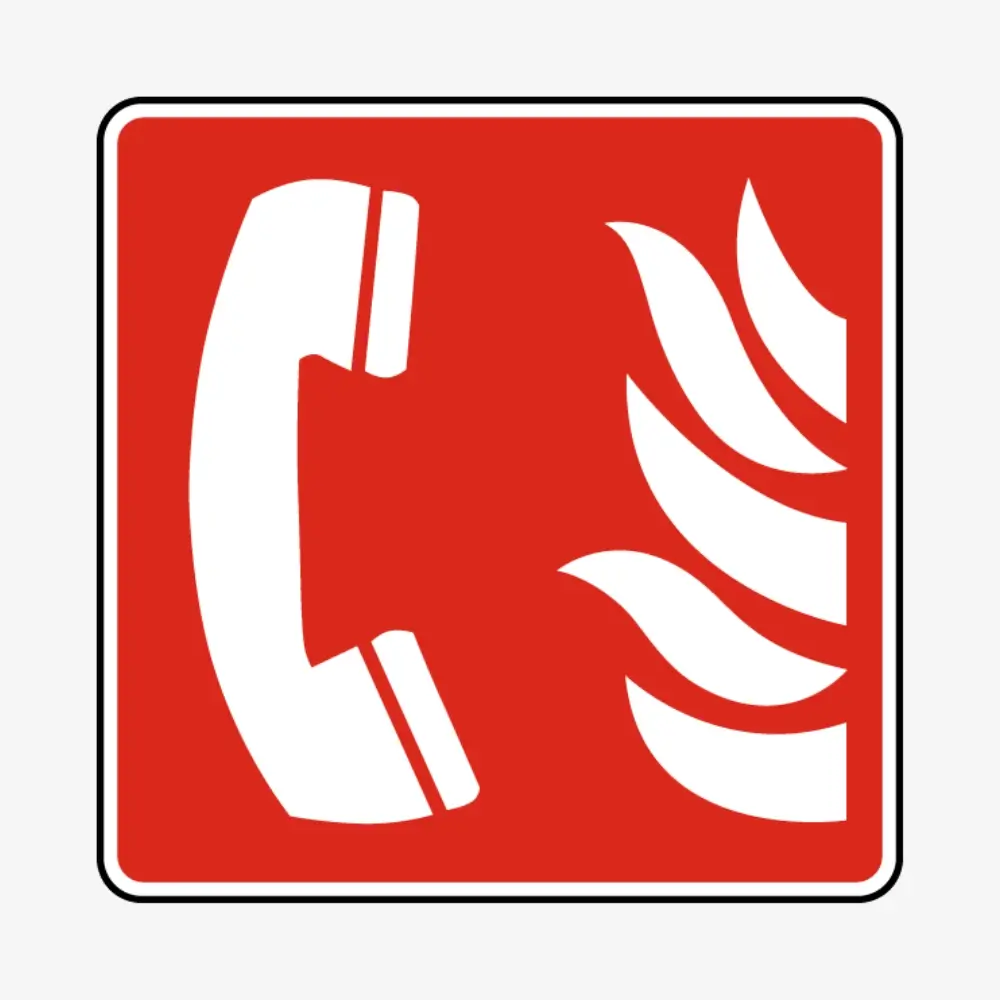
Emergency Telephone Signs are safety signs that indicate the location of telephones specifically designated for emergency use, such as contacting fire services, security, or other emergency responders.
Key Features:
- Appearance: Green background with a white telephone symbol, often accompanied by text like “Emergency Telephone.”
- Purpose: Guides individuals to the nearest emergency communication device during a crisis.
- Placement: Found inaccessible and visible locations, such as near fire panels, control rooms, or designated emergency stations.
These signs ensure quick access to emergency communication tools, enabling timely incident reporting and coordination with responders to enhance safety.
11. Fire Hydrant Sign

Fire Hydrant Signs are safety signs used to indicate the location of fire hydrants, which provide a water supply for firefighting.
Key Features:
- Appearance: Typically a yellow rectangular sign with a black “H” symbol and numbers indicating the hydrant’s size or distance, though designs may vary regionally.
- Purpose: Guides firefighters and emergency responders to the nearest fire hydrant for water access.
- Placement: Installed near fire hydrants, on walls, poles, or along roadsides, often at eye level for visibility.
These signs ensure that fire hydrants are easily located, saving valuable time in emergencies and enhancing efficiency of firefighting.
12. Do Not Use a Lift in Case of a Fire Sign
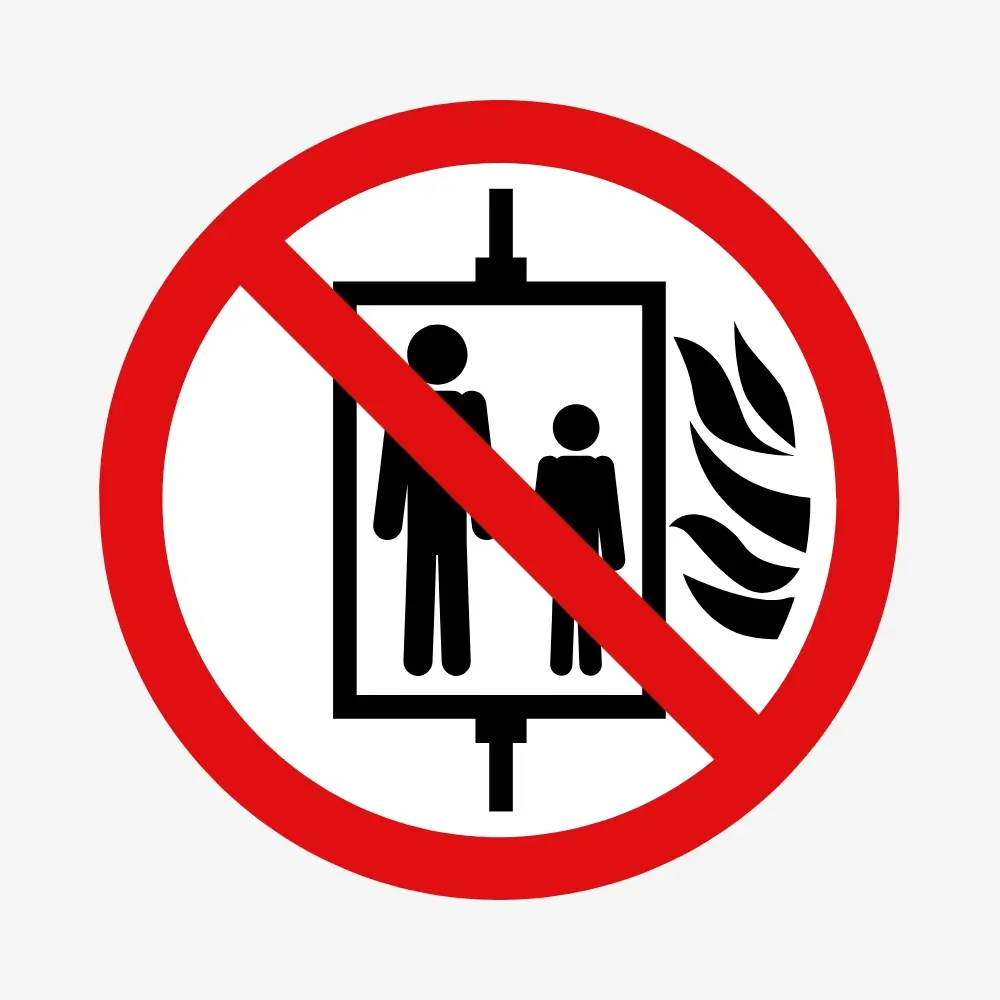
“Do Not Use Lift in Case of Fire” signs warn individuals not to use elevators during a fire emergency.
Key Features:
- Appearance: A red circle with a diagonal line over a lift (elevator) symbol, often accompanied by text such as “Do Not Use Lift in Case of Fire.”
- Purpose: Alert occupants that using lifts during a fire can be dangerous, as they may malfunction, lose power, or expose users to smoke and flames.
- Placement: Found near elevators and stairwells in buildings.
These signs encourage using safer alternatives like stairs, ensuring a secure evacuation during a fire emergency.
13. Fire Control Room Sign
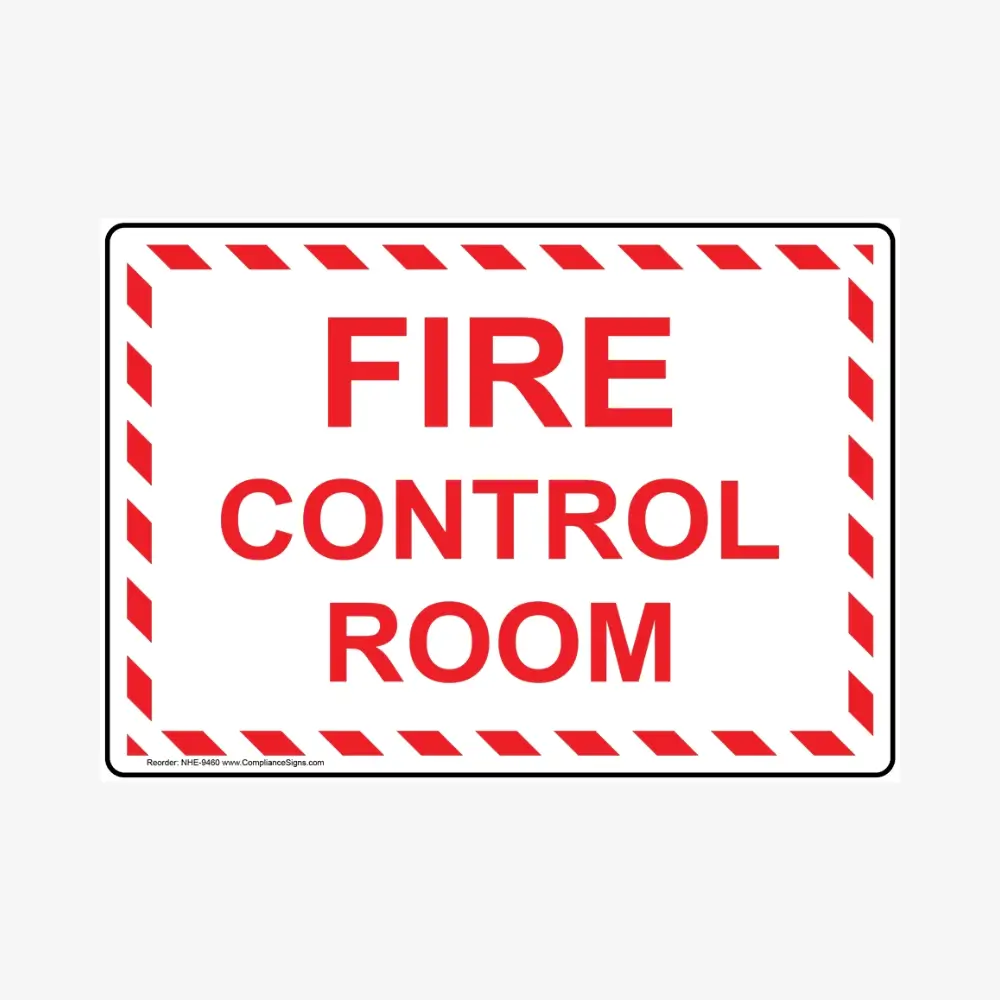
Fire Control Room Signs are safety signs that indicate the location of the fire control room in a building. The room houses critical firefighting and alarm systems.
Key Features:
- Appearance: A red or white rectangular sign with text such as “Fire Control Room,” sometimes accompanied by a relevant symbol.
- Purpose: Directs firefighters, emergency responders, and authorized personnel to the control room where fire alarm panels, communication systems, and other emergency controls are located.
- Placement: Installed on or near the entrance to the fire control room, typically at eye level for easy visibility.
These signs help ensure quick access to vital fire management systems, enabling effective response and coordination during an emergency.
14. Fire Sprinkler System Sign
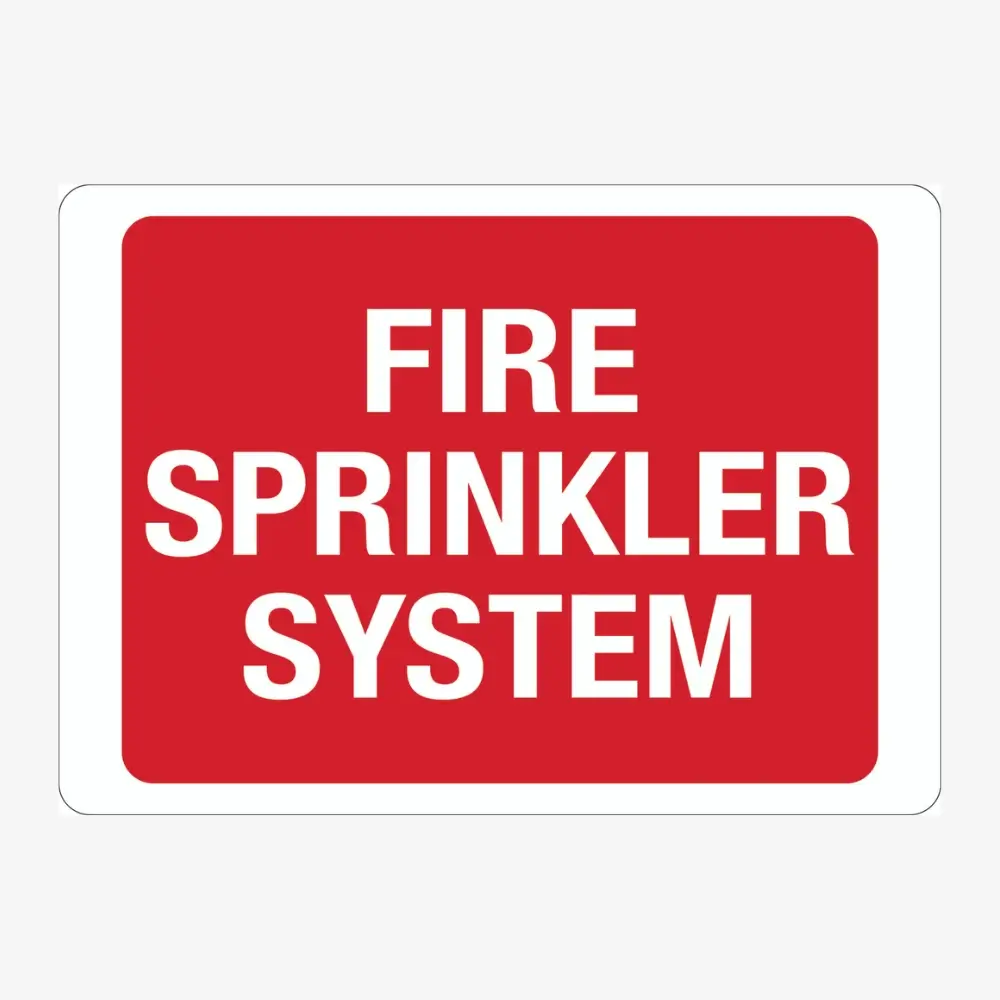
Fire Sprinkler System Signs are safety signs used to indicate the presence and location of a fire sprinkler system in a building.
Key Features:
- Appearance: A red rectangular or square sign with a white symbol of a sprinkler head or text such as “Fire Sprinkler System.”
- Purpose: Identifies areas with a sprinkler system to aid fire suppression and inform responders of its presence.
- Placement: Positioned near control valves, pump rooms, or areas covered by the sprinkler system.
These signs ensure awareness of the fire suppression system, assist in maintenance and guide emergency responders in effectively managing fire control.
15. Fire Pump Room Sign

Fire Pump Room Signs are safety signs that indicate the location of the fire pump room, which houses pumps used to maintain water pressure for firefighting systems such as sprinklers and hydrants.
Key Features:
- Appearance: Typically a red rectangular sign with white text reading “Fire Pump Room” or a similar label.
- Purpose: Identifies the room containing fire pumps, ensuring quick access for maintenance or operation during an emergency.
- Placement: Positioned on or near the entrance to the fire pump room, usually at eye level.
These signs assist firefighters and authorized personnel locate critical fire suppression equipment, enabling effective fire response and system management.
16. Fire Escape Keep Clear Sign
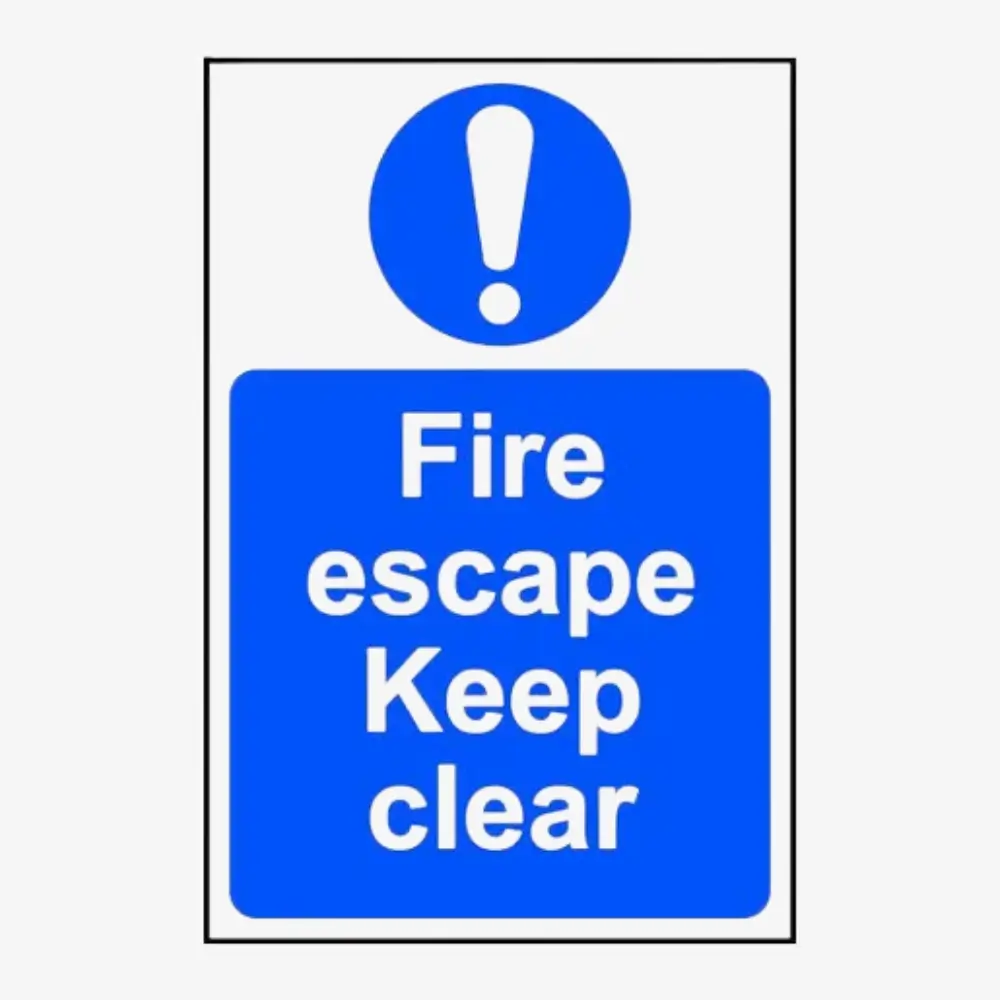
Fire Escape Keep Clear Signs are safety signs that remind people to keep fire escape routes and exits unobstructed at all times.
Key Features:
- Appearance: A blue circular sign with white text typically reads “Fire Escape Keep Clear.”
- Purpose: Warns and instructs individuals to avoid blocking fire escape routes or exits, ensuring they are accessible during emergencies.
- Placement: Positioned near fire doors, escape routes, and emergency exits where obstructions could occur.
These signs help maintain clear evacuation pathways, ensuring safe and quick egress during emergencies while complying with fire safety regulations.
17. In Case of Fire, Break the Glass Sign
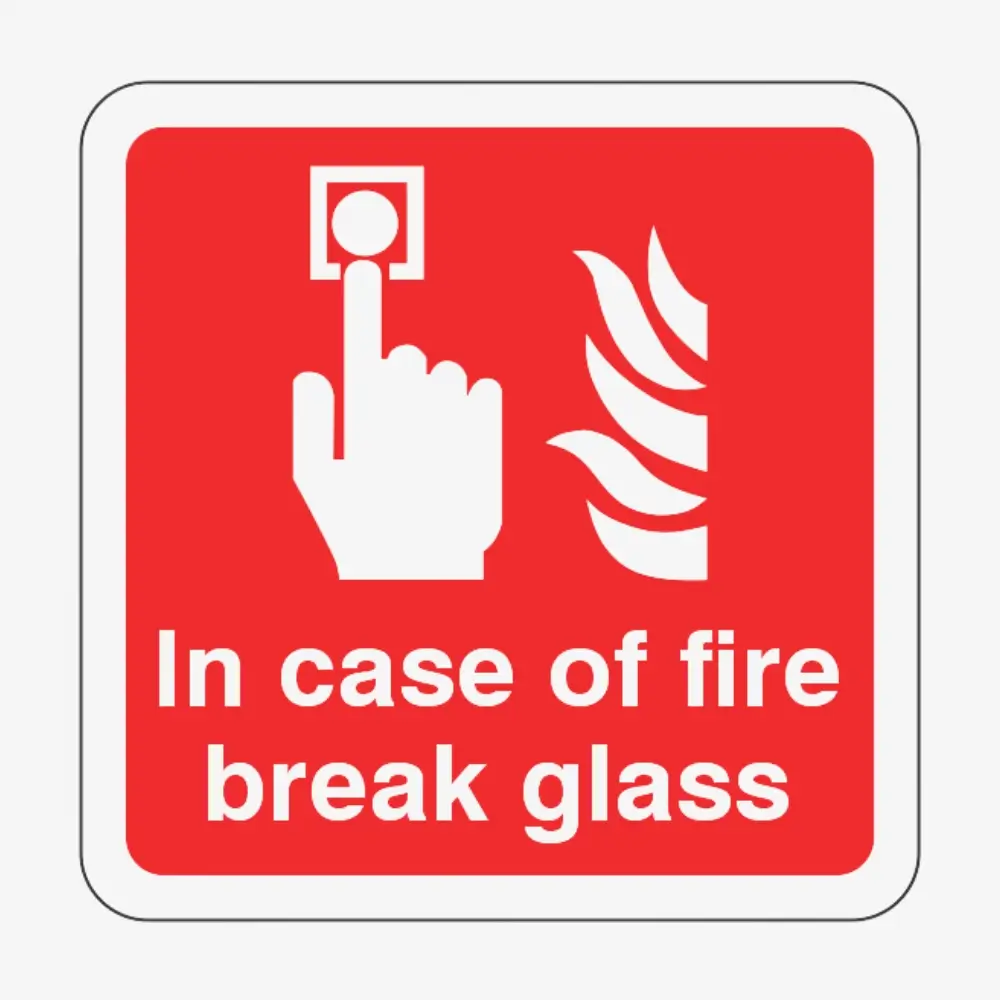
“In Case of Fire, Break Glass” Signs are safety signs indicating the location of emergency break glass units used to activate fire alarms or access firefighting equipment.
Key Features:
- Appearance: A red rectangular sign with white text and/or a symbol of a hand breaking glass.
- Purpose: Directs individuals to break the glass to trigger an alarm or gain access to emergency controls, such as fire extinguishers or keys.
- Placement: Located near break glass units, typically along escape routes, hallways, or exits.
These signs ensure that emergency systems can be activated quickly and efficiently, facilitating a rapid response during fire incidents.
18. Firefighter’s Lift Sign
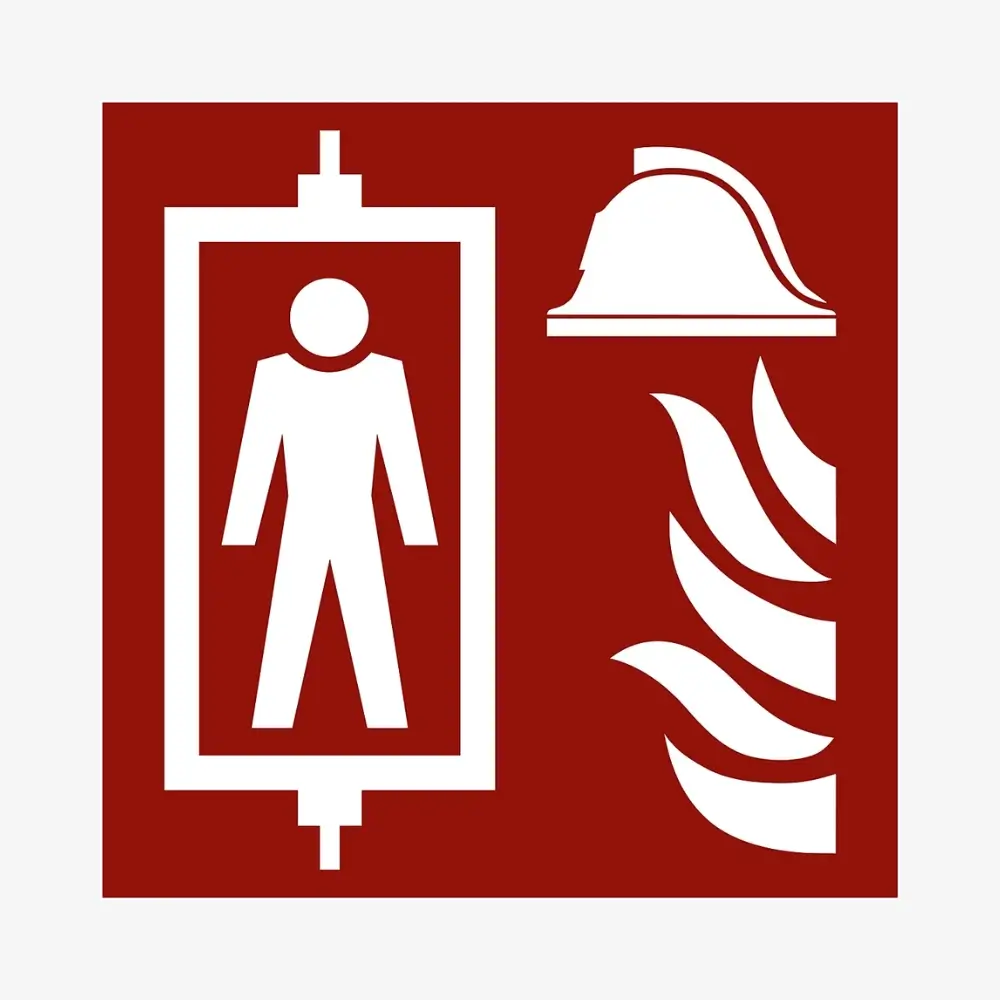
Firefighter’s Lift Signs are safety signs that indicate the presence of a specially designated elevator (lift) for firefighters’ use during emergencies.
Key Features:
- Appearance: A red rectangular sign with a white symbol of a lift and a firefighter figure, often accompanied by text such as “Firefighter’s Lift.”
- Purpose: Identifies an elevator designed for firefighters, equipped with features like fire-resistant cabling and manual override controls for safe operation during firefighting.
- Placement: Positioned near or on the firefighter’s lift, typically at the lift entrance.
These signs help firefighters quickly locate and operate designated lifts, enabling efficient movement of personnel and equipment during fire emergencies.
19. Fire Ladder Sign
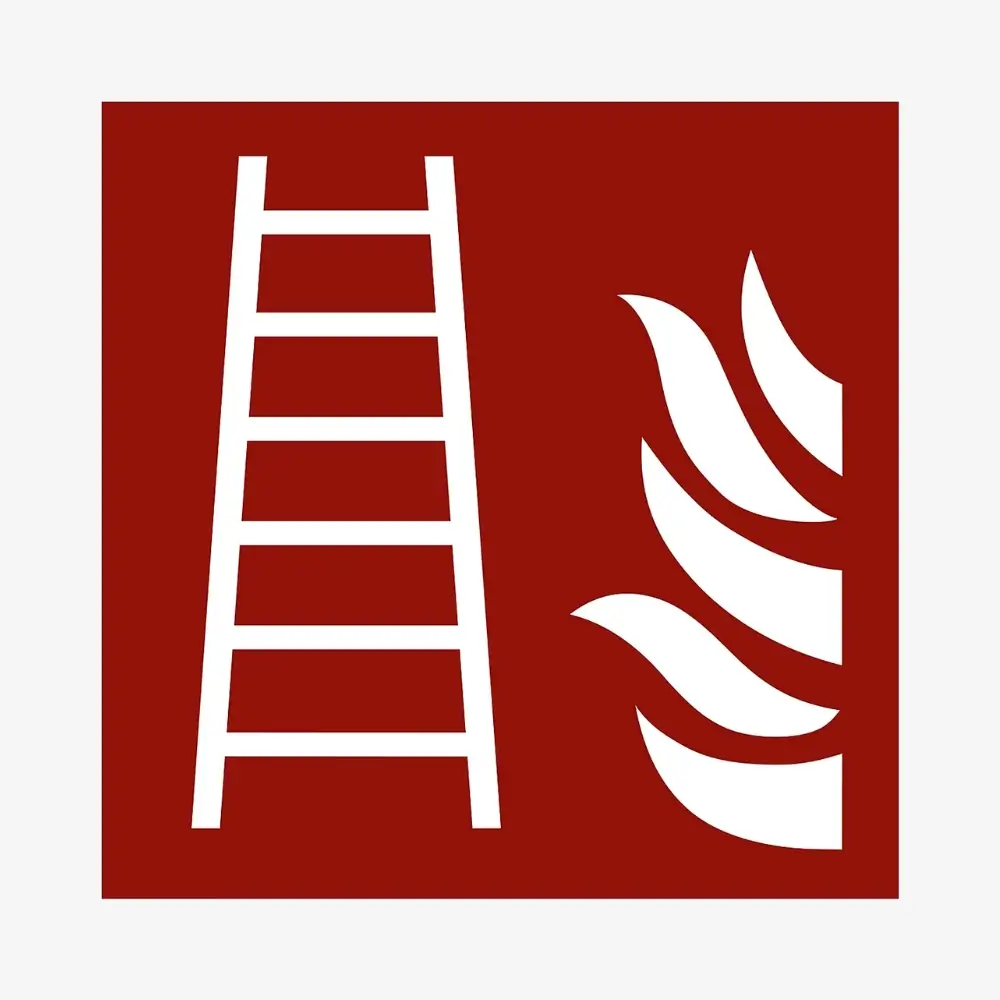
Fire Ladder Signs are safety signs used to indicate the location of fire ladders, which are essential for emergency access or evacuation during fire incidents.
Key Features:
- Appearance: A red rectangular or square sign with a white ladder symbol or text such as “Fire Ladder” is typically used.
- Purpose: Helps firefighters and emergency responders quickly locate fire ladders to access upper floors or assist in evacuations.
- Placement: Positioned near or at the storage location of fire ladders, such as in stairwells, corridors, or near emergency exits.
These signs ensure that fire ladders are easily identifiable and accessible, enhancing the effectiveness of emergency response and evacuation efforts.
20. Fire Protection Door Sign
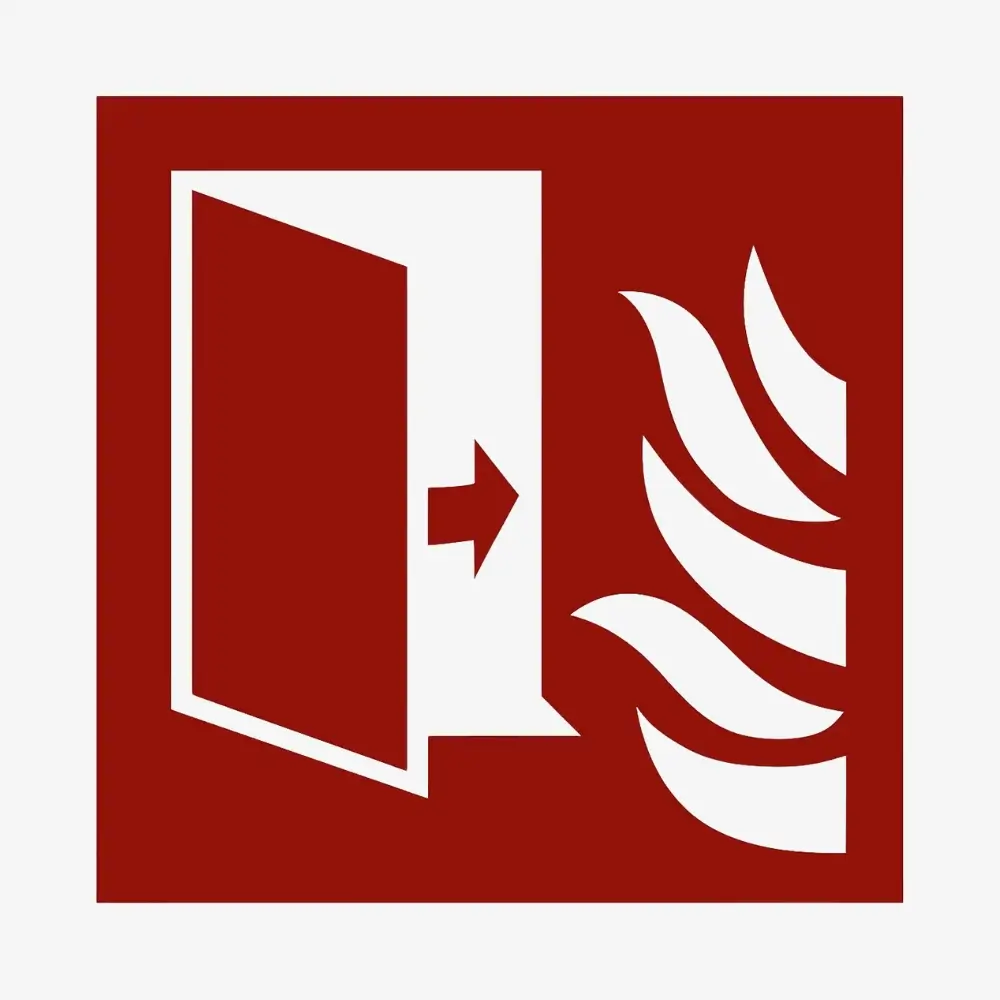
Fire Protection Door Signs are safety signs used to indicate the presence of a fire-resistant door designed to slow the spread of fire and smoke.
Key Features:
- Appearance: Typically, a blue circular sign with white text, such as “Fire Door Keep Shut” or “Fire Protection Door,” is displayed.
- The purpose is to inform individuals about the door’s function and provide instructions, such as keeping it closed to maintain its fire-protective properties.
- Placement: Installed on both sides of the fire protection door, usually at eye level.
These signs ensure that fire doors are used correctly, enhancing the safety of occupants by containing fire and smoke within designated areas and maintaining safe escape routes.
21. Fixed Fire Extinguishing Battery Sign
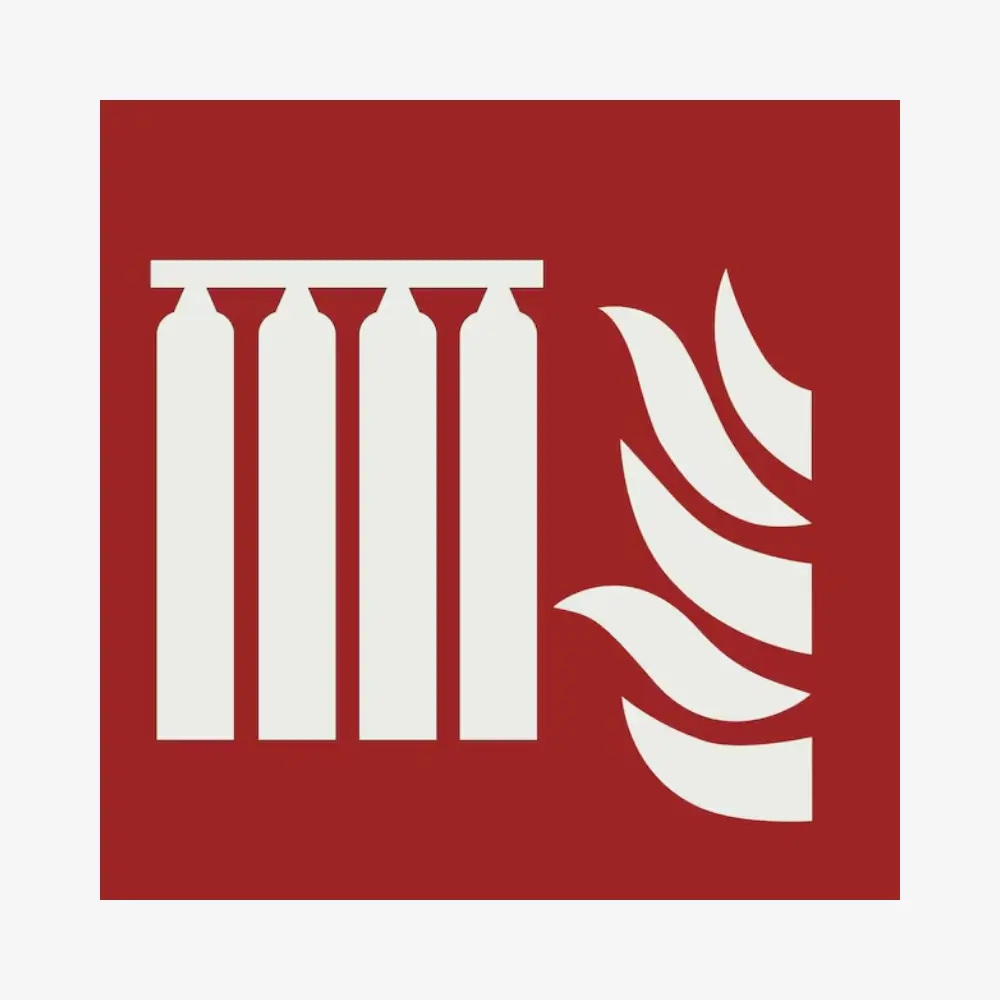
Fixed Fire Extinguishing Battery Signs are safety signs indicating the presence of a fixed fire extinguishing system, often comprising a set of extinguishing agents stored in cylinders or batteries, ready for automatic or manual release during a fire.
Key Features:
- Appearance: Typically, a red rectangular sign with white symbols or text depicting cylinders or a fire suppression system.
- Purpose: Identifies the location of fixed fire extinguishing systems, such as CO₂, foam, or gas suppression systems, used to control or extinguish fires in specific areas.
- Placement: Positioned near the control panels, cylinders, or the protected area, such as server rooms, industrial spaces, or kitchens.
These signs help emergency responders and maintenance personnel locate and identify fixed extinguishing systems, ensuring effective use and compliance with safety standards.
22. Wheeled Fire Extinguisher Sign
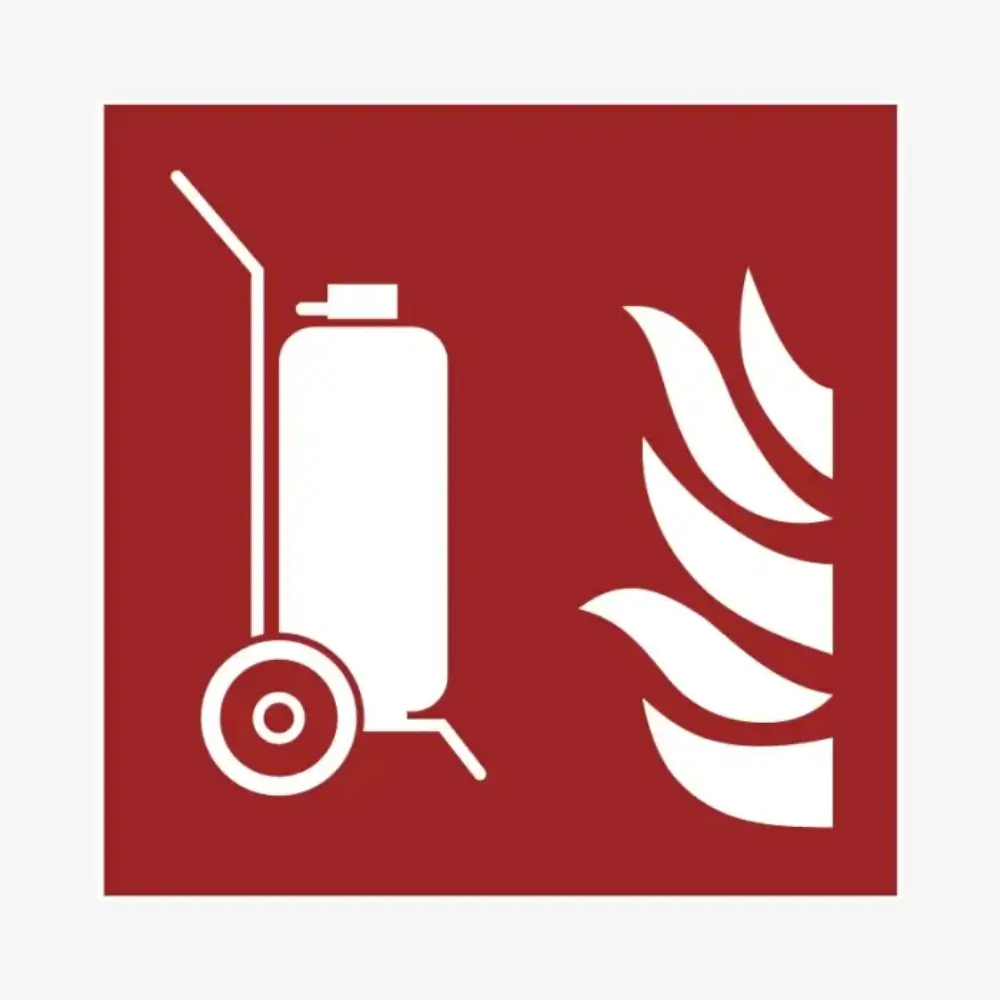
Wheeled Fire Extinguisher Signs indicate the location of large, portable fire extinguishers mounted on wheels, designed for use in industrial or large-scale fire scenarios.
Key Features:
- Appearance: Typically, a red rectangular sign with a white pictogram of a wheeled fire extinguisher or text such as “Wheeled Fire Extinguisher.”
- Purpose: This tool helps users quickly identify and locate wheeled fire extinguishers for controlling fires in areas with high fire risk or where larger quantities of extinguishing agents are required.
- Placement: Positioned near the storage location of wheeled fire extinguishers, often in industrial facilities, warehouses, or outdoor areas.
These signs ensure that wheeled fire extinguishers are easily identifiable, enabling quick access to powerful emergency firefighting tools.
23. Portable Foam Applicator Unit Sign
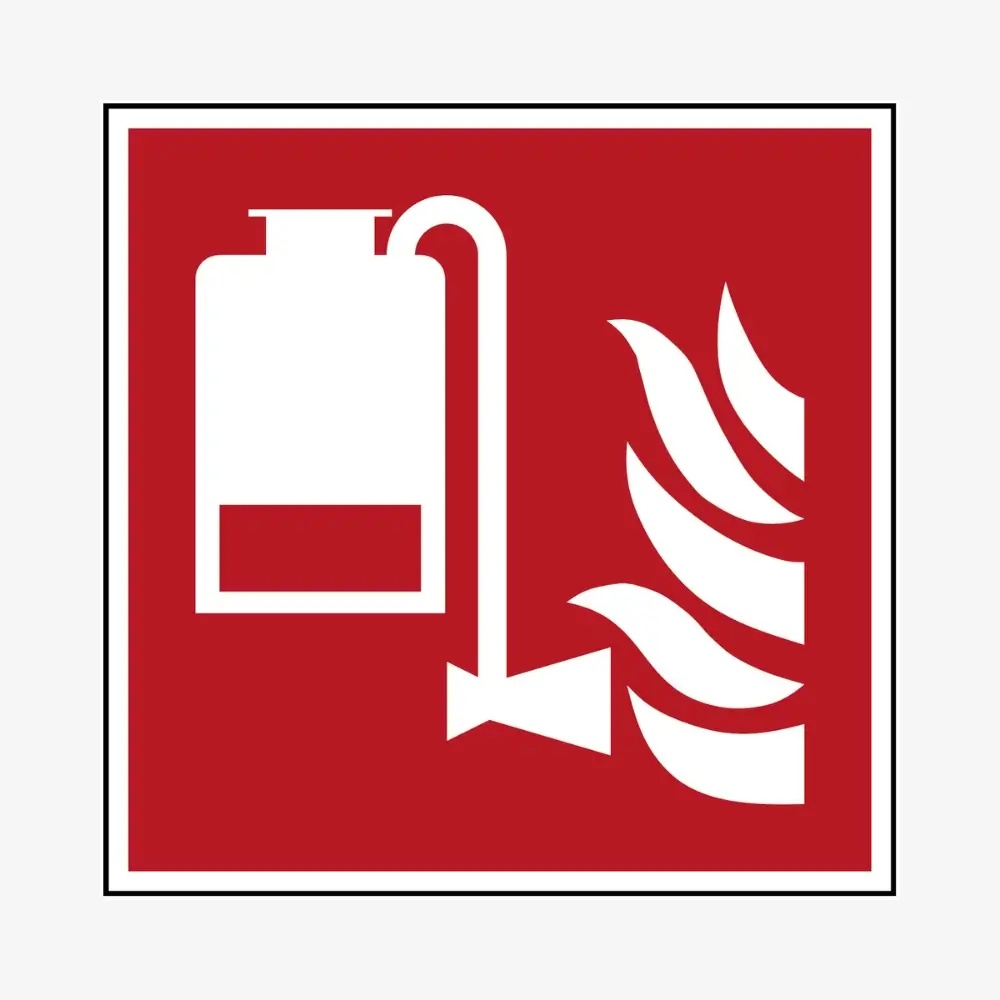
Portable Foam Applicator Unit Signs indicate the location of portable equipment used to apply foam for fire suppression, particularly effective against flammable liquid fires.
Key Features:
- Appearance: Typically, a red rectangular sign with a white pictogram of a foam applicator or text such as “Portable Foam Applicator Unit” is used.
- Purpose: Guides users to the location of foam applicator units for quick deployment during emergencies.
- Placement: It is commonly found in industrial facilities, chemical plants, or areas with flammable liquids near the storage area of the foam applicator unit.
These signs ensure the foam applicator unit is easily located and accessible, enabling rapid fire suppression and enhanced safety in high-risk environments.
24. Water Fog Applicator Sign

Water Fog Applicator Signs indicate the location of a water fog applicator, a firefighting tool used to produce fine water mist for extinguishing fires, especially those involving flammable liquids or confined spaces.
Key Features:
- Appearance: Typically a red rectangular or square sign with a white pictogram of a water fog applicator or text such as “Water Fog Applicator.”
- Purpose: Helps identify where the water fog applicator is stored, ensuring quick access during fire emergencies.
- Placement: Located near firefighting equipment storage areas, particularly in industrial sites, marine environments, or areas prone to flammable liquid fires.
These signs ensure the water fog applicator is easily accessible, aiding in effective firefighting and reducing the risk of fire spreading in high-risk settings.
25. Fixed Fire Extinguisher Installation Sign
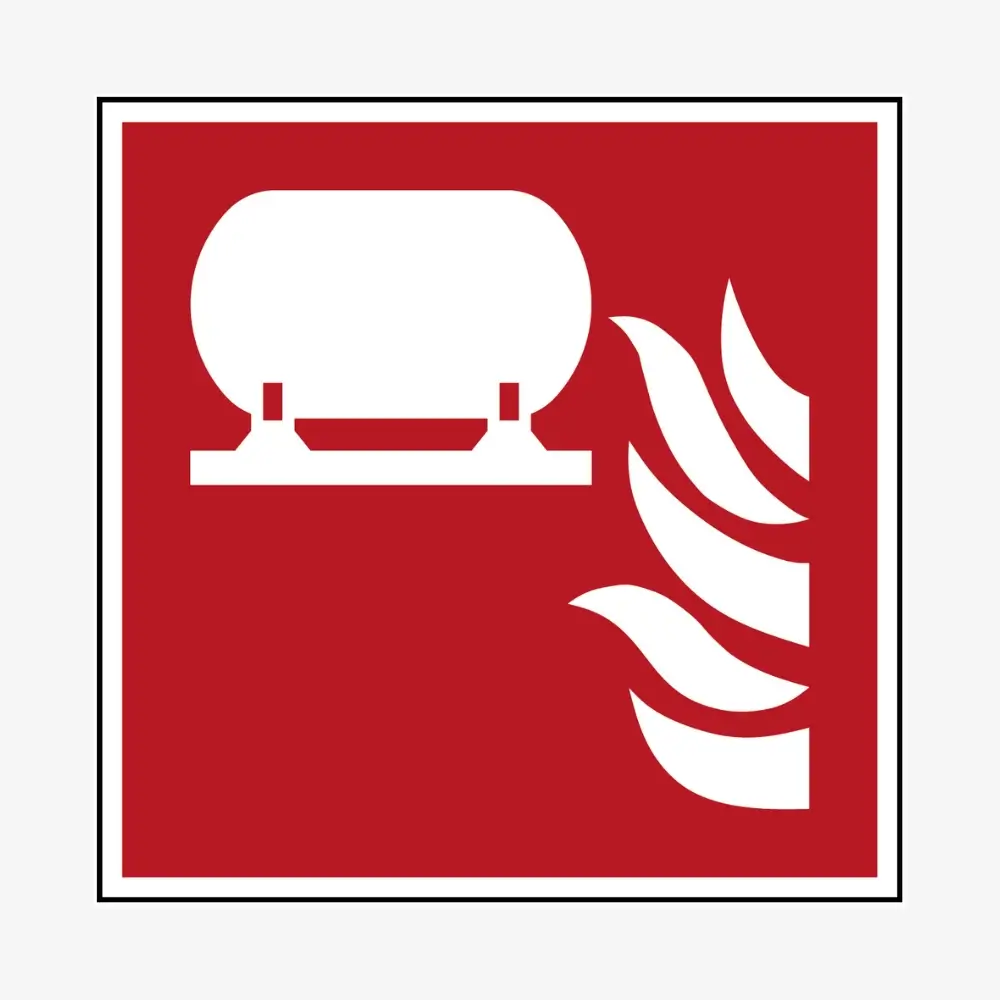
Fixed Fire Extinguisher Installation Signs indicate the location of a permanently installed fire suppression system designed to combat fires in specific areas automatically or with manual activation.
Key Features:
- Appearance: Typically a red rectangular or square sign with white text or symbols depicting the type of fire extinguishing system (e.g., CO₂, foam, or gas suppression).
- Purpose: Identifies the presence of a fixed fire suppression system, ensuring it is easily recognizable to personnel and emergency responders.
- Placement: Installed near the system’s control panels, discharge outlets, or the protected area, such as server rooms, kitchens, or industrial spaces.
These signs enhance safety by ensuring fixed fire extinguishing systems are easily located and understood, facilitating proper use during emergencies and compliance with safety regulations.
26. Fixed Fire Extinguisher Bottle Sign
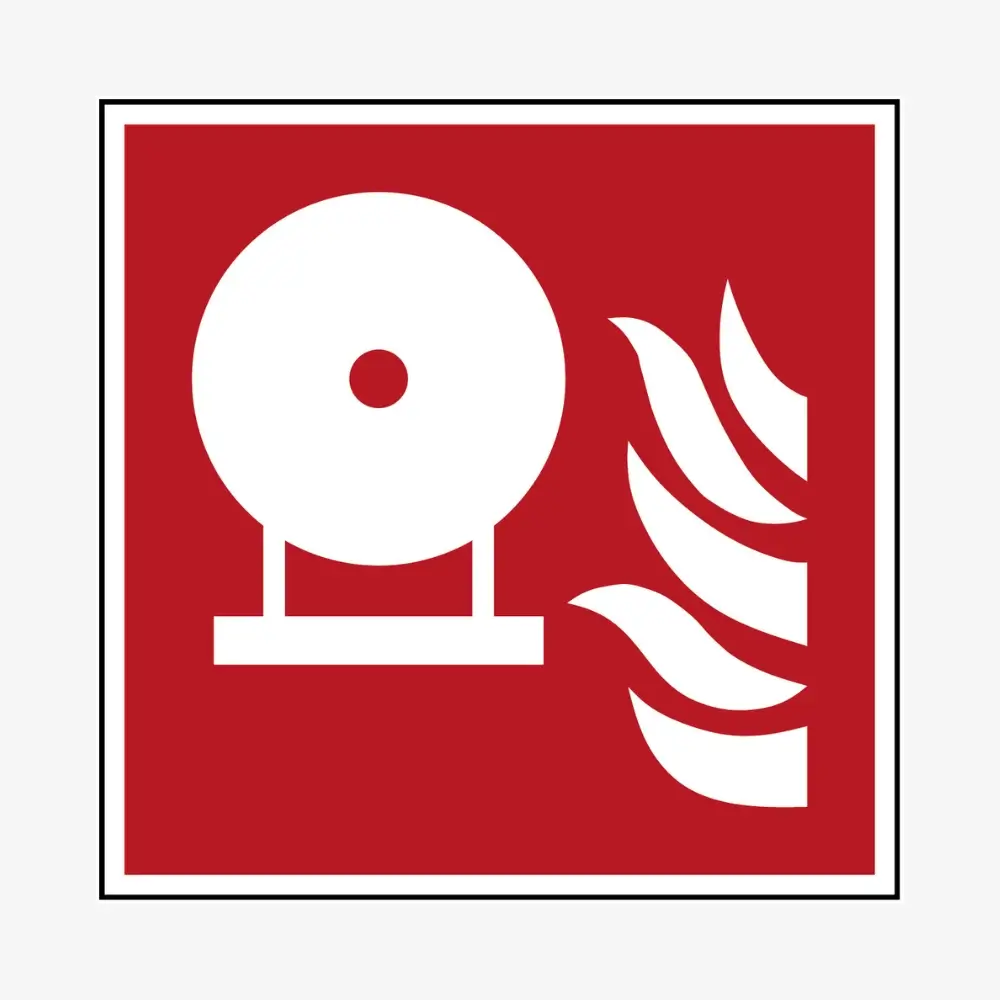
Fixed Fire Extinguisher Bottle Signs indicate the location of bottles or cylinders in a fixed fire suppression system used to store extinguishing agents like CO₂, foam, or inert gases.
Key Features:
- Appearance: Typically, a red rectangular or square sign with a white pictogram of a fire extinguisher bottle or text such as “Fixed Fire Extinguisher Bottle.”
- Purpose: Helps identify the location of extinguishing agent storage, ensuring accessibility for maintenance or emergency use.
- Placement: Positioned near or on the storage area of the bottles, such as in fire suppression system rooms or protected zones.
These signs ensure the quick identification and maintenance of fixed fire extinguisher bottles, enhancing fire response efficiency and compliance with safety regulations.
27. Remote Release Station Sign
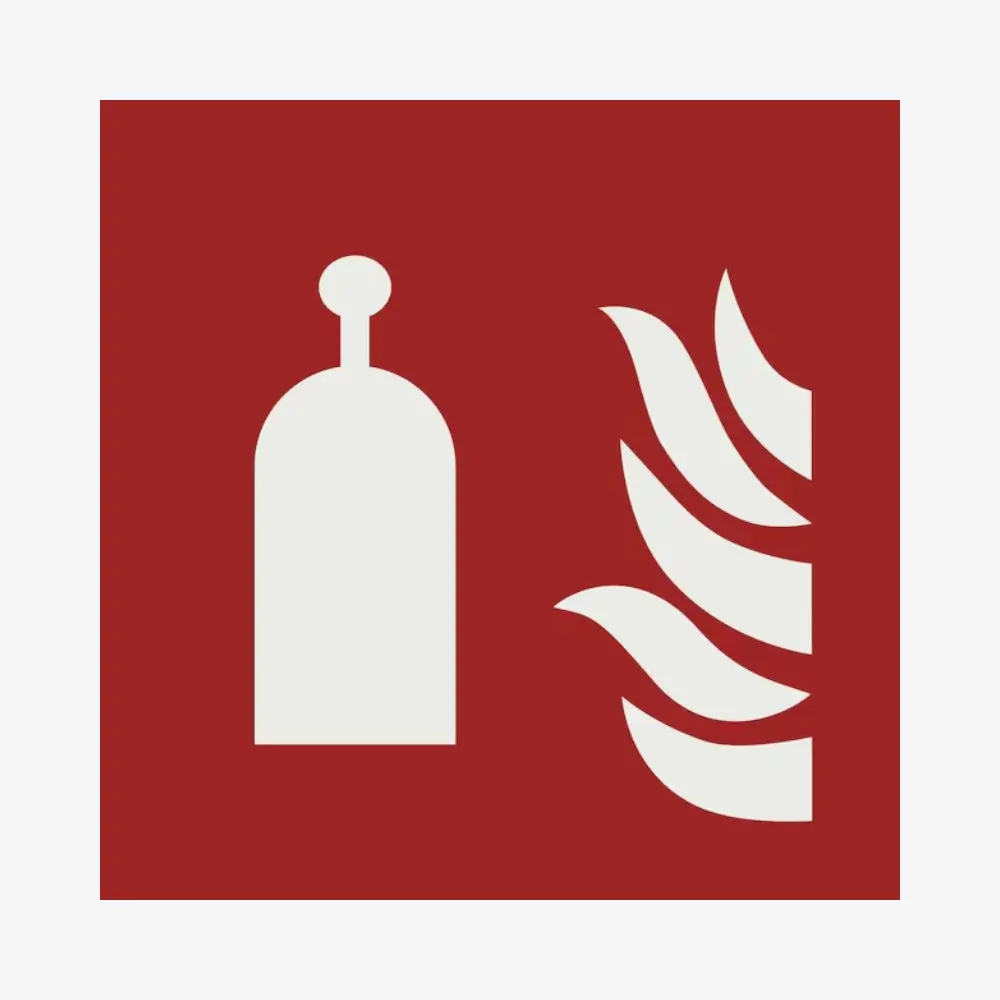
Remote Release Station Signs indicate the location of a control point used to remotely activate a fire suppression system or release firefighting equipment.
Key Features:
- Appearance: Typically, a red rectangular sign with a white pictogram of a release control or text such as “Remote Release Station” is displayed.
- Purpose: Guides users to the station where a fire suppression system (e.g., sprinklers, CO₂, or foam systems) can be manually activated.
- Placement: Installed near exits, control rooms, or inaccessible areas close to the protected zones.
These signs ensure that the remote release station is easily located and accessible during emergencies, allowing for quick activation of fire suppression systems to control and mitigate fires effectively.
28. Fire Monitor Sign

Fire Monitor Signs indicate the location of a fire monitor, a fixed or portable device used to direct high-pressure water or other firefighting agents at a fire.
Key Features:
- Appearance: Typically a red rectangular or square sign with a white pictogram of a fire monitor or text such as “Fire Monitor.”
- Purpose: Helps identify the location of fire monitors, enabling quick deployment or operation during a fire emergency.
- Placement: Positioned near or on the fire monitor, commonly found in industrial facilities, oil refineries, or marine environments.
These signs ensure that fire monitors are easily identifiable and accessible, facilitating rapid and effective fire control in high-risk areas.
29. Fire Alarm Flashing Light Sign
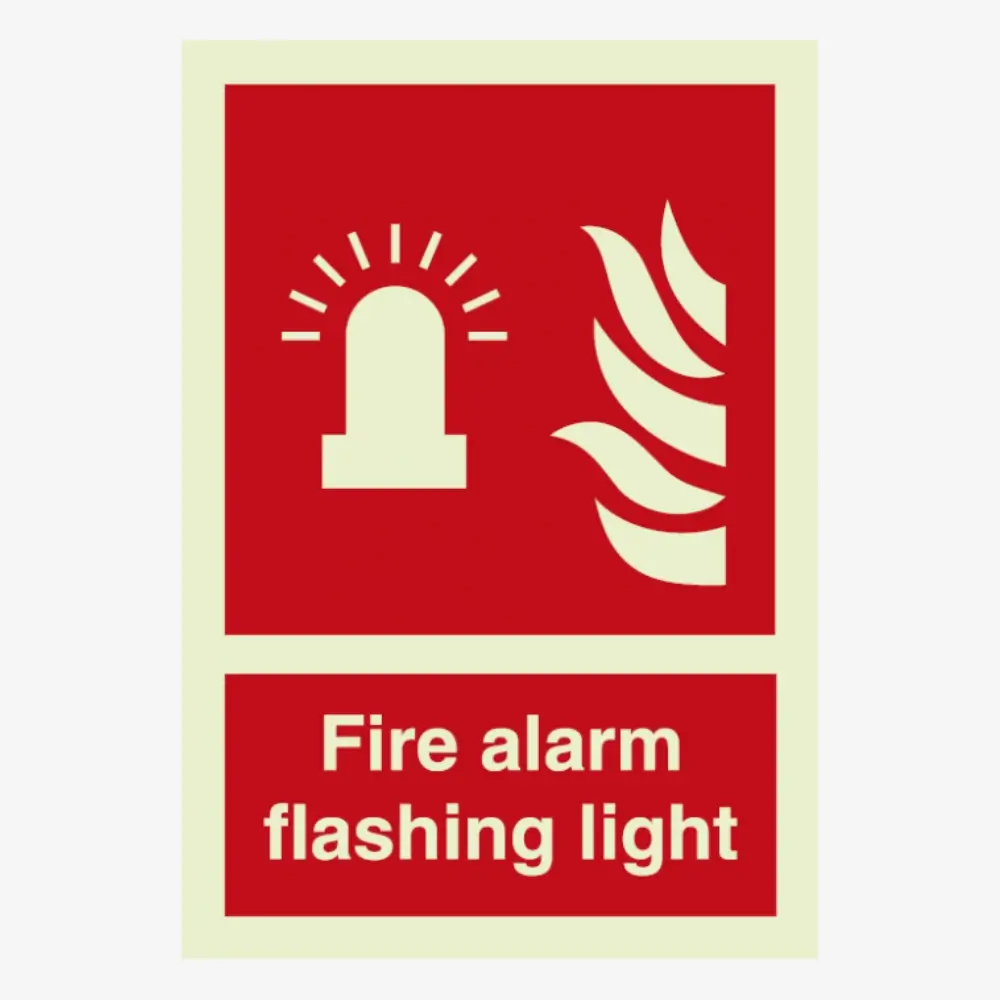
Fire Alarm Flashing Light Signs indicate the presence of a fire alarm system equipped with flashing lights to alert individuals, including those with hearing impairments, during emergencies.
Key Features:
- Appearance: Typically, a red rectangular or square sign with a white pictogram of a flashing light or text such as “Fire Alarm Flashing Light.”
- Purpose: Alert occupants to a fire alarm using a visual signal, ensuring everyone, especially in noisy environments or for those with hearing difficulties, is aware of the emergency.
- Placement: Positioned near the flashing light devices, often in hallways, common areas, or high-traffic zones.
These signs enhance safety by ensuring that the fire alarm system is recognized and its visual alerts are understood, improving evacuation efficiency and accessibility during emergencies.
30. Unconnected Fire Hose Sign
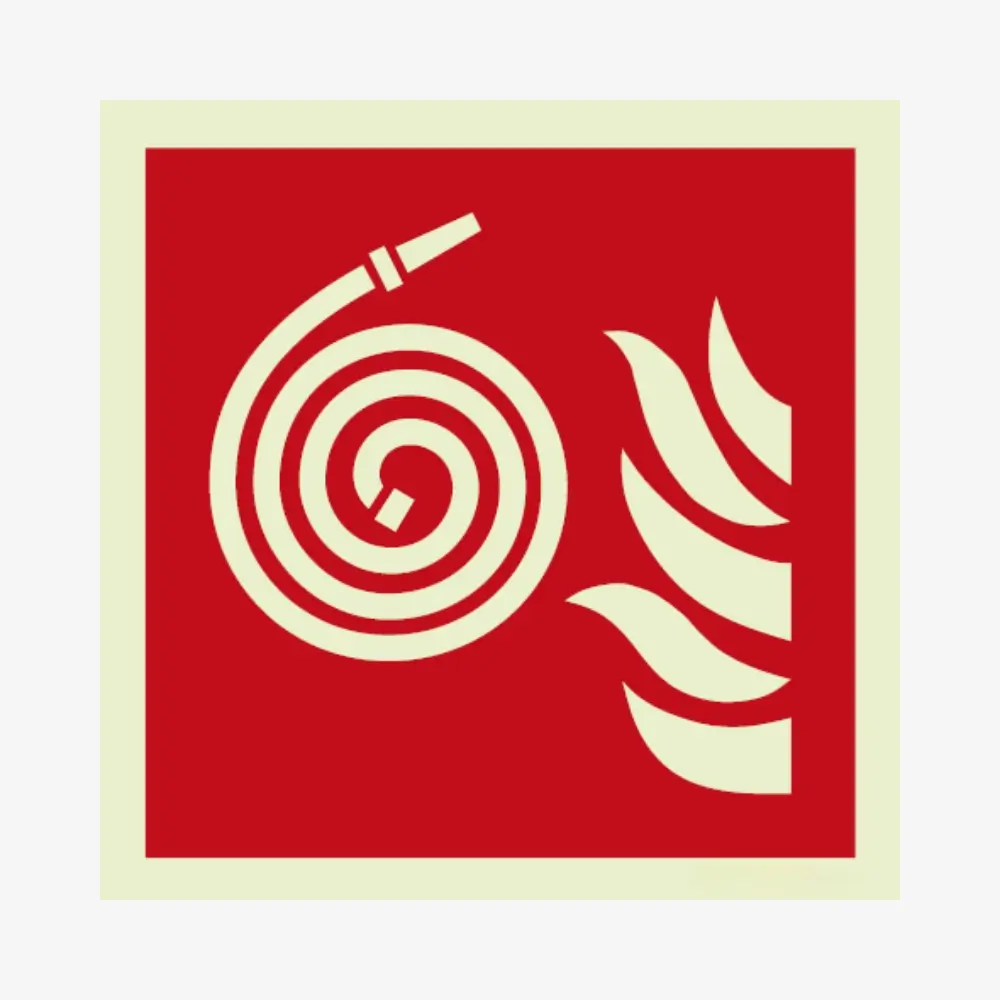
Unconnected Fire Hose Signs are safety signs that indicate the location of a fire hose that is not permanently connected to a water supply but can be connected when needed.
Key Features:
- Appearance: Typically, a red rectangular or square sign with a white pictogram of a hose or text such as “Unconnected Fire Hose” is displayed.
- Purpose: Identifies the location of unconnected fire hoses, ensuring they can be quickly accessed and attached to a water supply during emergencies.
- Placement: Positioned near the storage location of the unconnected fire hose, often in industrial or commercial facilities.
These signs ensure quick identification of unconnected fire hoses, enabling a swift and effective response to fire emergencies when additional firefighting equipment is required.
31. Direction Arrow 45° To The Right Sign

Direction Arrow 45° to the Right Signs are safety signs that indicate the direction to follow in an emergency or to locate safety equipment, escape routes, or assembly points.
Key Features:
- Appearance: A green or red sign with a white arrow pointing 45° to the right, depending on its purpose (green for escape routes or safe areas, red for fire equipment).
- Purpose: Guides individuals to turn 45° to the right to follow the designated path or locate the indicated safety feature.
- Placement: Installed at intersections or near corners, a 45° turn is required to reach the intended destination.
These signs provide clear directional guidance, ensuring smooth navigation during emergencies, reducing confusion, and enhancing safety compliance.
32. Direction Arrow 90° To The Right Sign

Direction Arrow 90° to the Right Signs are safety signs used to indicate that individuals should turn 90° to the right to follow an escape route, locate safety equipment, or reach an assembly point.
Key Features:
- Appearance: A green or red sign with a white arrow pointing directly to the right, depending on its purpose (green for escape routes or safety, red for fire equipment).
- Purpose: Guides people to turn right at intersections or corners to reach a specific location, such as an emergency exit or firefighting equipment.
- Placement: It is installed at decision points, such as hallways, corridors, or stairwell corners, where a right turn is necessary.
These signs provide clear and straightforward directional guidance, ensuring efficient navigation during emergencies and compliance with safety protocols.
Conclusion
Fire safety signs are more than just symbols on walls; they are life-saving tools that ensure clarity and guidance during emergencies. By understanding the purpose and placement of these 30+ essential fire safety signs, individuals and organizations can significantly enhance preparedness, streamline evacuation processes, and support compliance with safety regulations.
Whether directing people to exits, identifying firefighting equipment, or providing crucial instructions, these signs are pivotal in minimizing risks and protecting lives. Prioritizing the proper use and visibility of fire safety signs is a simple yet powerful step toward fostering safer environments for everyone.

